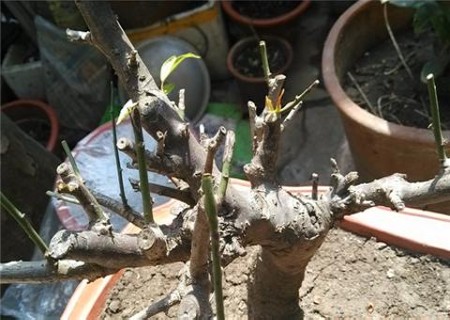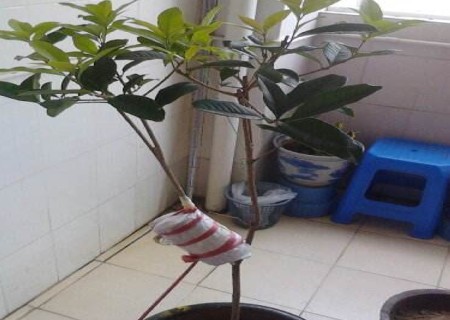High pressure Propagation of potted plants
Woody plants are more difficult to cut than herbaceous plants. People in this issue will often solve this problem perfectly and use high-pressure propagation to realize the reproduction of woody plants. "High pressure" is the abbreviation of high-altitude pressing strip. to put it simply, it gives a wound to a plant branch, and the root system is produced in the process of wound healing, which is in fact similar to the principle of cutting. only because the success rate of this method of reproduction is very high, and the whole process of reproduction is not separated from the female parent, alone as a reliable method of reproduction.

Branch pressing propagation can be divided into two methods: high pressure propagation and low pressure propagation. The advantages of high survival rate, especially the varieties that are not easy to survive by cutting, are suitable for high-pressure propagation, fast forming, early flowering and fruiting; disadvantages: relatively large workload of cutting propagation. The following is to introduce the technology of high-pressure propagation of plants:
First of all, do the necessary preparations for high pressure branches, such as containers, bamboo (wood) poles for support, ropes for fixing, knives for cutting, and so on.
Cut and peel the bark of the selected breeding and rooting area for about 2 to 1.5 centimeters. More than 2 cm is not easy to survive, less than 1.5 cm will heal if it does not take root.
Insert the bamboo (wood) pole used to fix the container into the underground soil, put it away and bind the container.
In order to prevent soil loss in the container, pebbles are properly placed at the bottom of the container.
Pour into the plain soil composed of appropriate fine sand and soil.
Finally, pour the water thoroughly until the current comes out. In the future, if it is not dry or watered, it will be cut off and planted on the pot or on the ground after taking root.
Explanation: why transparent plastic bottles are used as containers, because the rooting of branches can be seen directly. You can use something else as a container.
High success rate of high pressure propagation, suitable for cutting difficult to survive woody plants, such as rose, fruit trees and woody hydrangea and other ornamental or edible plants. Especially in the process of bonsai modeling, it is often used to facilitate the complete removal of the branches that need to be built. The following is a record of key points of the process:
1. Preparation tools: ring peeling knife (I don't have it, so I use Narcissus carving knife instead), tape, mineral water bottle, branch scissors, pen, scissors, culture substrate (I use peat, I can use water moss and other substrates, loose, water-retaining substrates can be used), rope (forgot to take pictures)
2. The selection of branches with high pressure is the best when the diameter is more than 0.5 cm. What I chose here is this branch I am holding in my hand, mainly because I want to give this June snow plastic surgery, and this branch is relatively strong, but it is a pity that it is cut and discarded directly, and the survival rate of cutting is not high, so I use the method of high-pressure propagation.
3. Prepare in advance, determine the part of high pressure, comb the branches with branch shears, and leave about 10 cm of unbranched parts.
4. Use the pen to determine the environmentally friendly parts for the next step (this step can be omitted), the distance should be controlled within 1 cm.
5. Gently cut off the bark and cambium (the green layer) with a carving knife. Note that this is the key to the success of high-pressure propagation. If only the surface bark is cut off without the cambium, it may lead to the failure of high-pressure propagation. Rotate and repeat the operation, the strength must be controlled, do not cut the whole branch, ha.
6. Cut off the bottom of the mineral water bottle about 12 centimeters high, cut it from the side according to the photo, and leave a hole a little bigger than the branch at the bottom.
7. Gently wrap the mineral water bottle around the girdled branches, fix the cut with adhesive tape, and control the wound in the middle.
8. Fill the matrix, because the branch I chose is oblique, so I roll it up with paper to form a funnel for matrix filling. The matrix is filled to completely cover about 2 cm above the girdling incision.
9. Water the substrate thoroughly. Because the branches are curved, I use small bricks as support to keep the water bottle from falling down and the branches can be controlled in the middle of the matrix.
10. Tie the upper part with a plastic bag to keep the moisture from losing easily.
11, follow-up management: plants carry out normal water, fertilizer and light management, pay attention to maintain the moisture of the substrate, watering can be injected upward with a needle, be careful not to touch the ring and peel branches, so as to prevent the new roots from being torn off. It takes about a month to take root in summer.
12. I carried out the high pressure on May 29 and did not transplant until July 20. With a mineral water bottle, you can clearly see that the capillaries have grown out. At this time, branch transplants can be carried out.
13. Gently take off the mineral water bottle and you can see that the root system has grown a lot.
14. Cut off the high-pressure branches with the shears and plant them in the new container for normal management.
Add: the survival rate of high-pressure reproduction is very high, as long as pay attention to small details, high pressure in spring, summer and autumn these three seasons, the survival rate is 100%, hey, are you eager to try, hurry up to operate on the woody plants at home.
Time: 2019-06-09 Click:
- Prev

The method of cutting and raising seedlings of Plum Blossom grafting
Plum blossom is usually propagated by grafting, because the seedlings are often not easy to transmit the good characters of the female parent, and the grafting is divided into cutting and bud grafting. We have talked about plum blossom bud grafting technology before, this article will talk about the plum blossom cutting seedling method! Needless to say, scion is the same as usual.
- Next

The method of striping propagation of sweet-scented osmanthus
Striping propagation is to make use of the habit of branches to take root in contact with the soil, to bury a part of the branch or its stem in the soil to let it take root, and then divide it into independent plants. The striping method is one of many flower propagation, which buries the branches of the lower part of the mother plant into the soil.
Related
- Fuxing push coffee new agricultural production and marketing class: lack of small-scale processing plants
- Jujube rice field leisure farm deep ploughing Yilan for five years to create a space for organic food and play
- Nongyu Farm-A trial of organic papaya for brave women with advanced technology
- Four points for attention in the prevention and control of diseases and insect pests of edible fungi
- How to add nutrient solution to Edible Fungi
- Is there any good way to control edible fungus mites?
- Open Inoculation Technology of Edible Fungi
- Is there any clever way to use fertilizer for edible fungus in winter?
- What agents are used to kill the pathogens of edible fungi in the mushroom shed?
- Rapid drying of Edible Fungi

